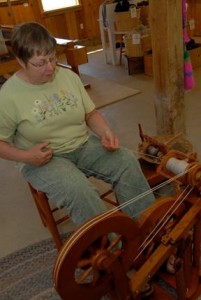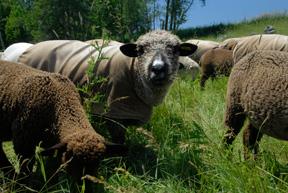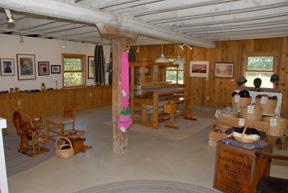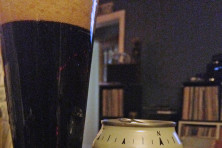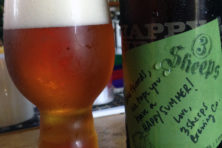Serendipity and a Flock of Sheep
- Share
- Tweet
- Pin
- Share
Gretchen Regnery spins, while Dick Regnery weaves. One may assume the couple met where their current passions intersect – a weaving class, a sheep auction, or a fiber arts gallery. Instead, the couple met in a manner that can be labeled nothing short of romantic – on a ship crossing the Atlantic in 1965.
“It was through the American Field Service,” Gretchen explains. “I was headed to Greece. Dick was headed to Denmark.”
“Serendipity,” Dick, a California native, interjects. Gretchen sits at her double wheel, custom made spinner, placed in the center of the first floor of their gallery, while Dick leans against his Swedish-made loom, a large, complex piece of machinery.
Against the backdrop of orchestra music – blaring horns, rhythmic drums, and humming violins – vivid photographs of barns, watercolors of running horses, indigo-colored scarves, silver jewelry and wooden bowls grace the walls and upturned crates scattered across the wooden floor. Through the windows appear green pastures, a growing garden, and occasionally grazing sheep. The venue is open and airy, showcasing rustic, natural materials and locations.
“Most people found us,” Gretchen says of the over 20 artists featured at the Whitefish Bay Farm Gallery. “They asked if they could be considered.”
In 1982, previous owners established the gallery, located in the nineteenth century farmstead’s old granary, and sold the property to the Regnerys in 1983.
“We were looking for property for five years,” says Dick. “We had connections and ties to the community. This seemed like the logical place.” The Regnerys’ relationship to the Door County area began with Gretchen. Her parents purchased a cottage in Door County when she was five years old.
“They expanded [the cottage] and turned it into a weaving studio,” she says.
Relocating from Gretchen’s hometown of Milwaukee, the couple began exhibiting a mix of art, weavings and photographs.
“Originally, we planned on having sheep and selling raw wool,” Dick explains. “That evolved to us using the wool, becoming much more active in the spinning and weaving.”
The couple learned their craft primarily from Gretchen’s parents.
“My mother was an art major. She was always experimenting,” remembers Gretchen. “We did tye-dyeing, macramé and weaving, which was her first love.”
When the Regnerys acquired the farm, Gretchen’s parents, both hand-weavers, managed the gallery while Dick and Gretchen renovated.
While most fiber artists keep a flock of 10 to 18 sheep or llamas, the Regnerys’ flock grew to become, according to Dick, “the largest flock in the county” with over 100 sheep. The art gallery expanded to the second floor of the old granary, and in 1991, the couple added a bed and breakfast.
The greatest challenge, Gretchen laughs, “is getting everything done.”
“It’s a balancing act,” says Dick.
But the greatest joy, “without a doubt,” says Gretchen, “is the sheep.”
“They are very therapeutic,” says Dick, “I never tire of them.”
He goes on to explain one of the features offered to the guests of their bed and breakfast: a farm tour.
“Every morning after breakfast, we go out to the pasture and everyone gets to meet the sheep. Most are city folks and this is the first time they have seen anything bigger than a cat and dog. It ends up being the highlight of their visit.”
However, Dick acknowledges, “The sheep are a business.”
The couple sells breeding stock all over the country. Gretchen cringes when she adds, “we sell the little boys for lamb chops.”
Primarily, the sheep are used for their wool, which is distributed worldwide. The Regnerys are involved in nearly every process, from spinning to dying to weaving and knitting. Shearing, however, is something they have left to a professional.
“Shearing is demanding, physically,” Dick explains. “It requires rigorous training.” For the past fifteen years, the Regnerys have hired the same shearer, a man who was trained in New Zealand and makes a living shearing sheep.
“He can do the entire flock in two days,” Dick states. “Whereas it would take me two weeks.”
Once the wool is sheared, the Regnerys take over, processing and selling the wool worldwide. Some of the wool is processed professionally then called ‘mill-spun yarn,’ while the rest is processed by the Regnerys, who sell the wool or keep it for themselves.
The Regnerys also spend time creating their own, organic dyes for some of their pieces.
“I occasionally set up a dye pot,” Gretchen explains. “We collect things throughout the year, plant material – such as marigold blossoms.” Gretchen cooks the collected materials, at least one pound of materials to dye merely four ounces of fiber, releasing the colors. Once the materials have been strained and water has been added, the fiber is dyed and treated with alum, which causes the fiber to change its physical structure and bind with the dye permanently.
However, you “don’t always know what you’ll get,” explains Dick. “It will never be the same color, so you can’t duplicate.”
Sometimes the colors that appear are a complete surprise, like the green that shone through when Gretchen cooked purple flowers – a delightful accident – something like serendipity.
Whitefish Bay Farm is located at 3831 Clarks Lake Rd (County WD) south of Jacksonport. The gallery is open Wednesday through Monday, noon – 5 pm. For more information, call 920.743.1560 or visit http://www.whitefishbayfarm.com.
Sally Slattery, a recent Winona State graduate, currently interns for the Peninsula Pulse Arts and Literature section. A visitor to the Door County area since she was a young girl, this season marks Slattery’s second to reside in the county.


